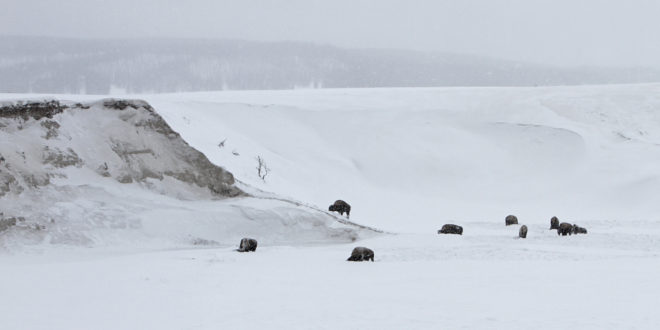With more bison in Yellowstone National Park, more wolves are benefiting from their winterkill.
Indeed, according to Yellowstone Wolf Project leader Doug Smith, speaking in a feature by Brett French for the Billings Gazette, the Park is “a pretty good place to be a wolf” with all the bison available.
Currently, there are approximately 5,500 bison in Yellowstone National Park. Per the Park’s estimates, around 9 out of every 100 bison perish during the winter, leaving behind a 1,000 to 2,000 pound carcass—a feast for wolves and other scavengers.
Smith adds that without bison, which comprise up to a third of an average wolf’s “scavenging activity” in the Park, Yellowstone’s wolves may not have enough resources to survive winter. From the Gazette:
Such a large source of food may be one reason the park contains the longest-known pair bond between two wolves ever recorded. Alpha male 712 will be 12 years old this March, an incredibly long life considering that on average Yellowstone wolves live only to age 5.
Wolf 712’s mate is a white female popular with photographers. Because she’s never been captured and collared, Smith isn’t sure how old the white wolf is, but she’s been with her black mate for more than seven years. Wolves begin breeding at 2 or 3 years old, so the female is almost as old as 712.
“It’s a cool story,” Smith said. “They’re probably the most famous wolves in the park.”
The two lead the Canyon pack, which roams the area around the Grand Canyon of the Yellowstone and Hayden Valley, north of Yellowstone Lake.
“This pack has been very comfortable near developed areas, exemplified by their use of a highway culvert to stash pups in 2008, denning near park headquarters in Mammoth Hot Springs in 2009, and regularly using roads as travel corridors during the winter months,” according to the Yellowstone Wolf website.
Given their familiarity with the park and its bison, Smith said the alpha pair’s winter routine is likely to include checking places where bison are known to die in hopes of finding a large, already dead meal.
“I can guarantee you they are going to all of their old spots,” he said.
These regular haunts are a boon to biologist like Smith, who regularly dart the animals from a helicopter, knocking them out long enough to collect physical data and fit wolves with GPS collars. Unfortunately, per Smith, it’s been too cold the past few seasons to reliably venture via helicopter in search of wolves. Last winter, Smith and company only collared twelve wolves; the long-term average is 20 to 22. Further, of those twelve, only seven had collars that worked the whole season. from the Gazette:
As a result, in two of the Northern Region’s larger packs, one has no collar and the other contains only one wolf with a working collar. The problem with the lack of collars was demonstrated in November and December when much of the Junction Butte pack disappeared from the park and wandered into Montana. While there, three members of the pack were legally killed by hunters north of the park. Park researchers are trying to understand the impact that the hunting seasons in surrounding states have on park wolves. Another three park wolves from the 8 Mile pack were also shot this hunting season, Smith said.
At last count, Yellowstone contained about 100 wolves in 10 packs, a population that has remained fairly stable since 2008. Lower wolf densities may be one reason that the park’s wolves haven’t had an outbreak of disease for eight years, defying researchers’ predictions that distemper would strike every three to seven years.
“Wolves are coming into equilibrium with the environment,” Smith said.
That equilibrium is important to biologists like Smith, who see wolves as important players in the Yellowstone landscape.
Last spring, Smith co-authored a study with colleagues Rick McIntyre and Kira Cassidy about the effects of hunting outside Yellowstone National Park on the Park’s wolf population. To wit: hunting outside the Park decreased the probability of wolf sightings inside the Park, owing to behavioral changes communicated by pack members. The study compared Yellowstone’s findings alongside those observed by Stephen Arthur and Nicholas Bromen in Denali National Park’s wolf population.
 Yellowstone Insider Your Complete Guide to America's First National Park
Yellowstone Insider Your Complete Guide to America's First National Park





